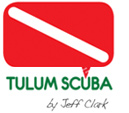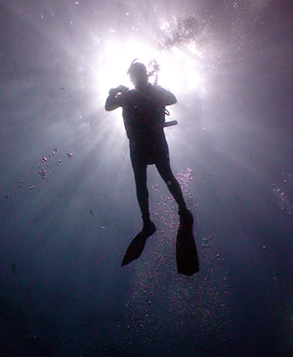The Riviera Maya has a lot to offer open water ocean diving amateurs. It’s a part of the second largest reef in the world: the Mesoamerican Barrier Reef System, which stretches from Isla Contoy down to the Bay Islands. The reefs of the Caribbean Sea offer spectacular and exciting diving opportunities and have a very pleasant water temperature ranging from 79°F to 84°F. The reef itself is an amazing symbiosis of organisms that have developed very different properties and abilities. The variety and vibrant life forms is so great that it could be compared with a tropical rain forest. in fact, you see more life on a tropical reef in 10 minutes than you would in 10 hours in a rainforest. We organize tours to sites in Akumal (20 km from Tulum), Puerto Morelos (80km from Tulum) and Tulum. depending on the weather conditions, your experience and personal interest you can choose between these locations. Upon additional arrangements we dive in Cozumel. Most of our dives sites are very close to shore. Boat rides are necessary and it takes an average of 10-15 minutes. This is a great place to expand your diving knowledge and continue your education. The dive sites are easy and safe, have little current and good visibility. All drift dives are from the boat with or without a descent line.
-
Y
alku lagoon: 20-50ft. situated directly in front of yalku lagoon, this shallow dive site is the most famous feeding site around, due to its constant flow of nutrients in and out of the lagoon. its water is brackish (mixed fresh and salt water).you can see many small daytime predators like gobies, blennies, wrasse and goatfish.under the extensive and climbing elkhorn coral structures, there are various tunnels to swim through.
Morgan: 40ft. this dive site is akumal’s best place to spot hawksbill, green, and loggerhead sea turtles. you can simply follow the reef, or enjoy coral and sponges below you and have turtles around you on the whole dive. local massive porites corals often host brightly colored spiral tube worms and hermit crabs. there are quite a few anemones and clownfish doing their ritualistic “dance” with anemone tentacles. truly an enjoyable place to dive.
Lobster: 40-50 ft. the dive site is like a little coral island in the middle of a sandy plateau, home for many baby lobsters and shellfish. this is the typical fringing reef that supports an abundant mixture of sponges and octocorals that grow from the hard coral base of the reef. Can be combined as a nice drift dive with another dive site las redes.
Half moon: 40-45ft. the dive site is a patch reef with sandy area between coral cracks. it is characterised by the diversity of shapes and colors with some beautiful hemispherical colonies of montastrea corals. you can admire all kind of herbivorous coral reef fishes like parrotfish, surgeonfish or damselfish. out in the featureless sand you can spot well concealed stingrays and hunting trunkfish in safety by day expanses far from the reef.
Las redes: 40-60ft. this site was named by the original explorers of the akumal reef for the giant commercial fishing net that was found blanketing it. the net has now been removed but the marine life still thrives. las redes is known for its abundant marine life, schooling fish, barracudas, stingrays, lobsters and if you’re lucky, turtles.
Motorcycle reef: 50-60ft. at the shallow end of this dive site lying in the sand there is a 15 year old, coral covered motorcycle where you can always find schools of feeding fish, arrow crabs and southern rays. this reef is laced with a large variety of soft corals, which makes it a good spot to see feeding turtles. green morays can be spotted in coral holes along with many barracudas, needlefish, and trumpetfish on the shallower part of the reef.
Horseshoe reef: 60-80ft. the horseshoe shaped reef is full of branching corals hosting day time hunters like triggerfish, filefish, trunkfish and puffers. many crustaceans and beautiful caribbean lobsters are also common to see. It’s a perfect site for an underwater naturalist dive. This is the best site to see southern stingrays buried in the sand, often leaving only their eyes and tail visible. be careful because the barb on their tail is serrated and covered in a venomous mucous, used for self defense and you barely see them hidden beneath the sand.
Gorgonians: 60-80 ft. this site offers lots of beautiful different genus of gorgonians and sponges. all of them grow on hard substrate and gorgonians form extensive fans that are all positioned at right angles to the current so they can filter plankton-bearing water. beautiful coral harmonies can be disturb by sudden pursuing predators like jacks which are running down their little prey.
Gonzalo’s reef: 60-80 ft. this site is decorated by large, vivid reef fingers. you are almost guaranteed to see hawksbill, green and loggerhead turtles here feeding, playing and checking out the visiting divers.
Xaak: 60-90 ft. this dive site is a very special deep dive. reef fingers reach up to 30 feet from the sea floor. turtles, nurse sharks, rays and a bright spectrum of fishes are common sightings here.
-
G
ardens: 45ft. this dive site name speaks for itself. you will swim through beautiful, colorful coral gardens, one of the best preserved in this reef system which belongs to the national marine park. also coral reef fish adaptations can be admired here in the variety of brilliant and sometimes bizarre color patterns that adorn them.
Puentes: 60 ft. this dive site is a part of the protected national marine park, preserving its rich biodiversity. the park was establish in 1998 and has some unique natural bridges covered with soft corals, swim throughs and larger fish. this area of the reef has a wide variety of fish such as grouper, barracuda, sergeant majors, trumpetfish as well as spotted eagle rays. the coral is joined together in most of the area and is one of the most beautiful marine landscape that can bee seen in puerto morelos. because of the way the coral is developed here you will see many schools of fish that consist of up to 50 or more, also single stalking barracudas and lots of morays.
The mineshipwreck juan escutia c-56: 90ft. one of the best dives in the area is the shipwreck juan escutia c-56. this ship was an admirable-class minesweeper built for the usa navy during wwII. this 120 foot navy ship was sunk on purpose for divers in the year 2000. most divers find wrecked ships irresistible because they’re intriguing to explore, exciting avenues of discovery and usually teeming with aquatic life. Around the shipwreck you can see large barracudas, different schools of fish, sting rays and spotted eagle rays. many large swim-throughs allow you to explore without needing wreck certification.
For advanced divers we offer the padi wreck diver courses with some limited penetration. this teaches you the ins and outs of rewarding, responsible wreck diving. more information about this program is on our courses page. -
T
ankha I and tankha II (coquitos): 30-50 ft. the best spot in tulum for coral and fish. numerous swim throughs and pinnacles are typical for this dive site. in the sandy areas you can encounter southern stingraysand in coral holes many caribbean lobsters and crabs. There is abundance of corals and with a bit of luck, a nurse shark or turtle.
Piscina: 45ft. this dive site is an easy and enjoyable spot with all kinds of coral, such as black coral, brain coral, fire coral and it’s just in front of the tulum ruins, which is nice to see from a different angle. many familiar tropical fish, turtles, barracuda, angelfish and rays can be found in between these dense coral formations. It’s a very good training spot.
Ballena: 40ft. this site has a characteristic rock that almost reaches the surface so when the waves come, it looks like a big splash made by whale’s tale – in spanish: ballena. interesting coral formations resemble points like the fingers on your hand. you can see lots of tropical reef fish, shellfish and lobsters.

